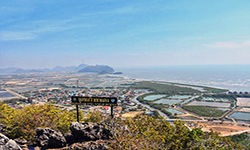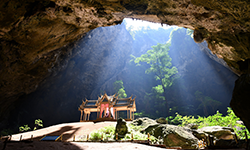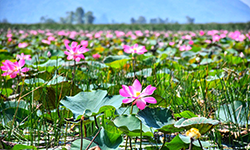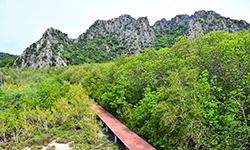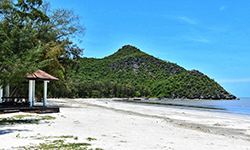Khao Sam Roi Yot National Park
Contact Location : Khao Sam Roi Yot National Park, Moo 2, Ban Khao Daeng, Khao Daeng Sub-district, Kui Buri District in Prachuap Khiri Khan Province 77150
Telephone Number : (+66) 3 282 1568,
Email : np_khaosamroiyot@hotmail.com
Facebook : Khao Sam Roi Yot National Park
Information
Khao Sam Roi Yot derives its name from the legend that this area was once an archipelago of large and small islands. Once, a Chinese junk was sailing through the strong winds of a storm, and they came to rest in the ditches on the west side of the island. But due to inexperience and a lack of knowledge, the junk collided with a rock. Many were drowned but it was said approximately 300 people survived and lived on the island, hence the name "Ko Sam Roi Rod" (300 survived island). Later in time, as the sea level drops, the island transforms into mountain. Locals refer to it as "Khao Sam Roi Yot" (mountain with 300 peaks) and refer to where the junk is believed to have sunk as "Ao Thale Sap” (lake bay). Remnants of ancient junk masts have been discovered in this area to verify the story. Some said because there were Sam Roi Yot trees grown in the area, or some said there are many mountain peaks as many as 300.
The wetland area of Thung Sam Roi Yot covers 69.22 square kilometers, and on December 16th, 1970, the Cabinet approved a resolution to relocate people living in the park.
The land in the area is either clay-based or saline-alkali land, and one-third of the area floods throughout the year, so agriculture is difficult to develop. The National Park status aims to preserve the site's natural state as it is a habitat for no less than 157 species of birds. To help local people, the Land Classification Committee only annexed half of Thung Sam Roi Yot, but later changed the National Park border by annexing the province of Thung Sam Roi Yot in 1982, with an area of 36.8 square kilometers. It was added to the National Park and made a total area of 98.08 square kilometers.
Khao Sam Roi Yot National Park area is in the lower central region of Thailand. Its northernmost point is on the southwest coast of the Gulf of Thailand in Sam Roi Yot Sub-district, and Kui Buri District in Prachuap Khiri Khan Province.
Background
In 1962, the Ministry of Agriculture and Cooperatives issued Ministerial Regulation No.100, designating area of Khao Sam Roi Yot Fores covering approximately 99.50 square kilometers, and it became a National Reserved Forest under the Forest Protection and Reservation Act 1938. The declaration was made in response to the repid growth of irreplaceable plant species such as Sandalwood, Afzelia Wood, Ebony Tree, and Senna garrettiana (Craib) H.S.Irwin & Barneby. The area also has beautiful scenery which should be preserved.
Later, an area of 61.28 square kilometers was declared a National Park when information was published in the Government Gazette Vol. 83, Section 53 on June 28th, 1966. It became Thailand’s fourth National Park in Thailand and the first Marine National Park in the country.
Note : After paying the entrance fee to the National Park, please carry the receipt for inspection.
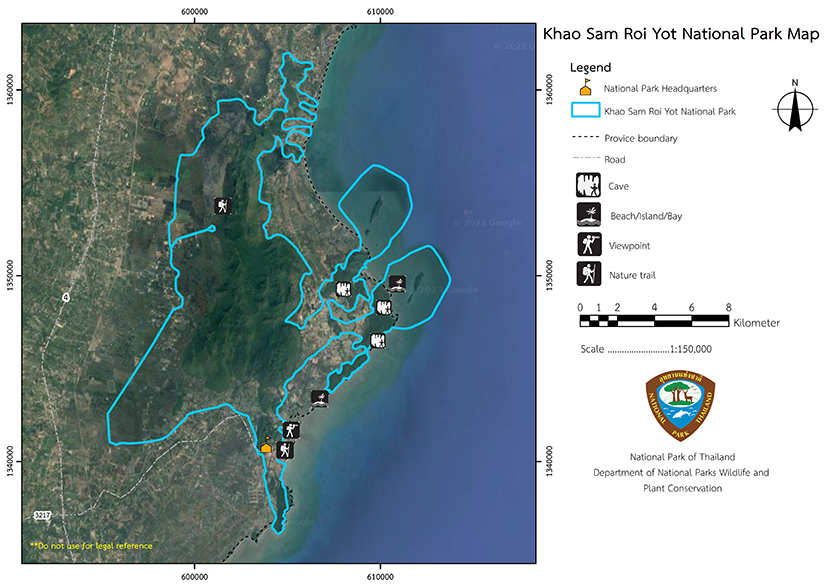
61,300 rai (98.08 square kilometers)
|
|
|
|
|
|
|
|
|
Thung Sam Roi Yot (Bueng Bua) |
Mangrove Swamp Forest Nature Trail |
|
|
Sam Phraya Beach |
Leam Sala Beach |
|
Nature trails ⇔ Cave exploration/Geological condition ⇔ Observe flowers/plants ⇔ Bird/Butterfly ⇔ Camping
Welfare shop : The National Park Headquarters is open daily from 8:30 to 16:30 hrs. and sells coffee, drinking water, and snacks.
The Sub-National Park Ranger Station (Hat Sam Phraya) is open daily from 8:00 to 20:00 hrs.
Mobile phone signal:
- National Park Headquarters: AIS, TRUE, DTAC
- Sub-National Park Ranger Station (Hat Sam Phraya): AIS, TRUE, DTAC
|
|
The topography of Khao Sam Roi Yot National Park is comprised of a karst topography with rocks dating from Permian Period, approximately 28-230 million years ago. The rugged coast is mixed with coastal plains, lagoon beaches, and shallow seas. There are many limestone islands located near the coast, from Khao Kralok in the north to Khao Rang in the south, across a distance of about 30 kilometers. Islands include Ko Kho Ram, Ko Nom Sao, Ko Rawang, Ko Rawing, Ko Sattakood, and Ko Ki Nok. Khao Sam Roi Yot features karsts with steep slopes made of limestone. It has deep valleys, and the highest summit in the National Park is as high as 605 meters above sea level. The highest mountain summits are Khao Chalong Fang, Khao Krachom, Khao Yai, Khao Tham Prathun, Khao Daeng, Khao Thian, Khao Hup Chan, and Khao Khan Bundai. There are many places in which limestone is found, and limestone helps form caves, such as Kaeo Cave, Sai Cave, and Phraya Nakhon Cave. These have been created by natural erosion or weathering, making caves or grand canyons. |
|
The weather in the park is influenced by monsoons. There are 3 main seasons. Winter is between October and February is cool and dry, with temperatures between 18 and 25 degrees Celsius. Winter is calm, so the the influence of local winds and waves can be clearly noticed; land winds blow toward the inner shore. The sea breeze blows off the shore at night. Due to the mountainous terrain and varied climate, the ecosystems in Khao Sam Roi Yot National Park are multiple. The areas can be divided into two main characteristics: wetlands and land based: |
|
|
|
• Mangroves Swamp Forest line the banks of Bangpu Canal, Khao Daeng Canal , and Lam Rang Sakha stream branches. Plants are Olive Mangrove, Rhizophora apiculata, Rhizophora mucronata, Excoecaria agallocha, Xylocarpus moluccensis (Lam.) M. Roem, Ceriops tagal (Perr.) C. B. Rob., Navy Bean, Bind-Poll, Garden Quinine, Nypa, and Derris trifoliata Lour. The term "Sam Roi Yot" is used to refer to both a national park and a mountains, but it is also the name of a plant, which is also called Creeping Club Moss. Other plants, such as Dracaena surculosa Lindi and Vine Spike Moss are plants closely related to ferns found throughout Thailand, particularly in the south and east. There are two types of stems: ground-level stems and erect stems that can reach a height of 0.5 meters. These grow in pine forests, and have small leaves. Propagation organs take the form of dangling blisters near the plant's tip, which are called Cones. Sam Roi Yot grows best on sandy soils in hillside plains that receive bright sunlight, and is found on flatlands and on slopes up to 1,000 meters. Khao Sam Roi Yot National Park offers a wide variety of wildlife, especially bird species, which at least 316 species of resident and migratory birds. It is one of the few places in Thailand where the Purple Heron nest and breed. Important resident birds include the Lesser Whistling Duck, Slaty-Breasted rail, White-Browed Crake, and Purple Swamp Hen. From the survey and data collection, no less than 45 species of fish and other aquatic animals were found, including Striped Snake Head Fish, Walking Catfish, Nile Tilapia, Minnow, Silver Barb, Swamp Eel, Short-Bodied Mackerel, Indian Mackerel, Diamond-Scaled Gray Mullet, Stingray, Mudskipper, Banana Prawn, Splendid Squid, Green Tidal Crab, Blue Swimming Crab, Apple Snail, Pond Snail, and Green Mussels. There are also many other types of animals such as Common Mormon, Small Grass Yellow, Dragonfly, Chironomids, Rice Grasshopper, Cricket, Red Cotton Bug, and Horseshoe Crab. |
How to get there by car :
Khao Sam Roi Yot National Park is located in Sam Roi Yot and Kui Buri Districts of Prachuap Khiri Khan Province. Khao Sam Roi Yot National Park Headquarters are locatedbetween the milestone No. 286 – 287 on Phetkasem Road, which are There are three ways to get from Bangkok to the National Park:
Route No. 1: Travel along Highway No. 35 (Thonburi - Pak Tho Road) before turning onto Highway No. 4 (Phetkasem Road) in Pak Tho District. Travel through Pranburi, before turning left along Pak Nam-Pranburi Road for 4 kilometers to Pranburi intersection, where visitors will observe a signpost. Turn right onto the paved road for 31 kilometers to the Khao Sam Roi Yot National Park Headquarters.
Route No. 2: From Bangkok, take Highway No. 4 (Phetkasem Road) towards Kui Buri District. Approximately 7km before Kui Buri District , turn left after the milestone No. 286, and it is about 14 kilometers to Khao Sam Roi Yot National Park Headquarters.
Route No. 3: Departing from Bangkok, take Thon Buri-Phutthamonthon-Nakhon Chai Si highway, then turn left onto Highway No. 4 and head to Phetchaburi, Cha-am-Bypass. Follow the route to Pranburi District . At Pranburi Intersection, turn left onto Pak Nam – Pranburi Road for 4 kilometers. Visitors will see a sign pointing towards the park. Turn right onto the road, then continue on a paved road for about 31 kilometers to the Khao Sam Roi Yot National Park Headquarters.
Pick-up truck or motorbike taxis are to be used to get to Khao Sam Roi Yot National Park Headquarters. Another option is by train. All southern trains pass through Pranburi district and Kui Buri districts. Most express, or fast, trains will not stop except Bangkok - Hat Yai route. All slow train stops at Kui Buri station and it is convenient to get to Khao Sam Roi Yot National Park rather than to other means.
In addition to National Highway No. 4, Phetkasem Road that passes near the park, there is also rural road separated from Pak Nam - Pranburi Road. It is separated from Pak Nam - Pranburi Road at the confluence with Phetkasem Road at Pranburi Intersection, where the Pak Nam- Pranburi Road meets with another Phetkasem road at the milestone No. 286.5 (Ban Samrong Intersection), which is a road where people living around the park live as the main transport route. There are also paved roads. Another line connects various coastal villages and meets the rural road. This route is mainly and regularly used by vehicles such as small cars, motorcycles, and pick-up truck.
Visitors can use water transport only for sightseeing.
- National Park Ranger Station So Yo No. 1 (Ban Hua Tan Thaeo)
- National Park Ranger Station So Yo No. 2 (Laem Sala Beach)
- National Park Ranger Station So Yo No. 3 (Rong Che)
- National Park Ranger Station So Yo No. 4 (Khao Khan Bandai)
- Campground on Laem Sala Beach
- Campground on Sam Phraya Beach

